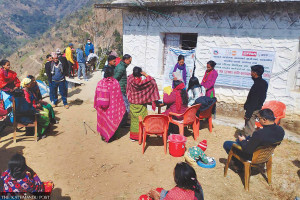 16.12°C Kathmandu
16.12°C KathmanduEntertainment
Authentic, cathartic and humorous
Binaash’s Prateek Raj Neupane discusses why the band takes a darker tone in their upcoming album ‘Pagalos Bowlamu’.
Ayse Turcan
A guitar riff that promises mischief is followed by the hiss of the cymbal, and then the beat sets in: Slow, sluggish, threatening. The drummer hammers the bass drum with both feet to produce the genre-typical double bass. As the beat sets in, vocalist Prabin Shrestha begins to growl into the microphone.
Growling is the term for the way metal singers create sounds through rumbling their often dark lyrics, using their voice to transmit content, but also as an instrument. It often sounds rather animalistic than human. Or devilish. Within a few seconds, the tiny rehearsal room around the corner of Kathmandu’s Freak Street is filled with loud, mean music.
The band rehearsing is Binaash, a Nepali term for ‘destruction’. On this evening, apart from the self-titled song about the 2015 earthquake, they mostly play songs from their upcoming album ‘Pagalos Bowlamu’, releasing Saturday. The band members have been active in the music scene for a long time and have played in other bands, but the man on the guitar has been in the scene for so long, one could call him a living legend. Together with his first band, Ugra Karma, Prateek Raj Neupane was one of the first people to do death metal in Nepal. “We didn’t do it because we wanted to be the first; we just happened to be,” he explains about Ugra Karma’s demo from the year 2000, which became known as the first death metal recording in the country’s history.

Death metal is a subgenre in the wide variety of metal styles. Some genres are faster, others slower, some mostly sing about satan, others are political, some vocalists growl deep like thunder, others squeal like pigs, some styles are known for their complex guitar riffs, others for how the guitar sound is distorted. What most of them have in common is probably the lust for heavy, loud and brutal sound and for provoking in some way or another. Death metal, in particular, is characterised by the frequent changes in tempo, from very fast to super slow and back, as well as by the theme of the genre, which is predominantly and unsurprisingly: death. Prateek Raj Neupane’s fascination for death metal is rooted in his teenage years. “When you are young, you look for the most extreme stuff,” he says. And the most extreme sound he got his hands on as a kid was death metal. “I also liked punk, but musically, it is not as aggressive as metal.”
Ever since his teenage days, Neupane’s love for death metal stuck. After a few years, his first band suffered the same fate as many others: migration. “Several original band members left the country,” Neupane recalls. Fans and band members going abroad is one of the reasons why the metal, as well as other underground scenes, always stay relatively young and fresh in Nepal. To avoid this from happening again, Neupane looked for more ‘mature’ people to play with, hoping they would stick. 2006, this attempt resulted in the founding of his second band, 72hrs. Musically, the band was leaning stronger towards thrash metal. But Neupane says the members of 72hrs tended to settle down and change priorities—away from music. The third band that Neupane co-founded has lasted longer than others. Even though some band members left and new ones joined, Binaash has existed since 2009. Guitarist Neupane found two musicians he knew from other bands and two young people who were eager to play—all of them craving death metal.
Apart from their shared love for music, Neupane lists two features that distinguish Binaash from other death metal bands. First is their authenticity. “We are known as a band that doesn’t pretend,” Neupane says and specifies: “No fancy metal language, no ‘Let’s go to the battlefield!’ when we release an album or so.” That, indeed, is something that stands out since there are enough metal bands who are likely to be posing in their appearance, sound and during gigs.
The second is connected with the striving for realness: humour. “You can be funny, even if you do death metal,” says Neupane. That is particularly why Binaash has coined the genre designation ramailo (fun) death metal for their music. Neupane says it is a reminder not to take things too seriously.
However, the album releasing on Saturday is less funny than its predecessors. “I was in a very dark place while working on that,” reveals Neupane about the period in which the new songs were created and he had a difficult time putting his thoughts on paper. Vocalist Shrestha eventually helped to find a solution for his blockade. Shrestha asked Neupane to hang out and share his thoughts and feelings and suggested transforming the conversation into lyrics. So they did, and it worked. From this evolved the new album: dark, doomy and less funny than usual.
For those questioning why one should listen to the new album despite it coming off a little ‘sombre’, do it for its cathartic potential. “I was in a dark place, but now, after working on this, I’m happy,” he reflects, adding that he believes channelling negative emotions into music played a role in his current state. Whether it’s death metal or any genre, music is a form of expression, a means of “releasing anger in creativity”, according to Neupane. This applies not just to creators but also to listeners, especially during live gigs, creating a sense of community and belonging.
And after all, the songs on the new album are not completely stripped of all humour. Around twenty minutes into the rehearsal, with beads of sweat running down the drummer’s forehead, Shrestha introduces a track saying, “This song is about a butcher and what he can prepare with the meat!” Metalheads and music fans can join the experience on Saturday at Purple Haze Bar in Thamel, Kathmandu, to discover what the butcher does and whose meat it is. The entrance fee to the show includes a digital copy of the album.
















